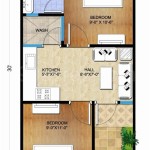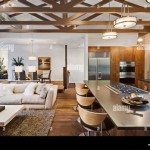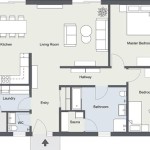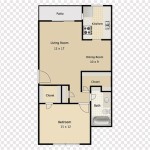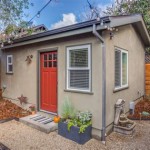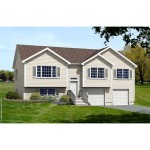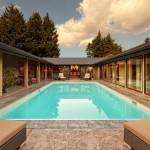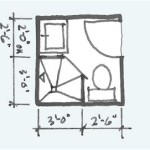Small Mother-In-Law House Plans: A Comprehensive Guide
The concept of a "mother-in-law house," also often referred to as an Accessory Dwelling Unit (ADU) or granny flat, has gained considerable popularity in recent years. These self-contained living spaces, typically located on the same property as the main residence, offer a multitude of benefits for both homeowners and their extended families. Small mother-in-law house plans are specifically designed to maximize functionality within a compact footprint, providing comfortable and private living arrangements while adhering to potential zoning restrictions and budgetary constraints.
The rise in demand for these types of dwellings stems from evolving family dynamics, increasing housing costs, and a growing desire to create multi-generational living situations. Aging parents can maintain their independence while remaining close to their children and grandchildren, while young adults can save money on rent while establishing their careers. Furthermore, homeowners can potentially generate rental income by leasing the ADU to tenants, providing a financial benefit to the property owner. The design of these small dwellings requires careful consideration of space utilization, accessibility, and aesthetics.
Key Point 1: Planning and Zoning Considerations
Before embarking on the construction of a small mother-in-law house, thorough research into local zoning regulations is paramount. These regulations dictate the permissible size, placement, and design of ADUs on a given property. Many municipalities have specific requirements regarding setbacks from property lines, maximum square footage, parking provisions, and even architectural style. Failure to comply with these regulations can result in costly delays, fines, or even the forced removal of the structure.
The first step involves contacting the local planning department or building permit office to obtain detailed information about the relevant zoning codes and ordinances. It is crucial to understand the specific definitions of ADUs within the municipality, as the terminology and regulations can vary significantly from one jurisdiction to another. Some areas may require a conditional use permit, while others may have more lenient regulations for ADUs occupied by family members.
Density requirements are also essential to consider. Many zoning codes restrict the number of dwelling units allowed on a single lot. If the main residence already utilizes the allowable density, obtaining approval for an ADU may be challenging. Furthermore, parking requirements can pose a significant obstacle, particularly in densely populated urban areas. The ADU may need to include dedicated parking spaces, which can impact the overall design and cost of the project.
In addition to zoning regulations, homeowners must also consider building codes, which govern the structural integrity, safety, and energy efficiency of the structure. These codes typically require adherence to specific standards for foundations, framing, electrical wiring, plumbing, and HVAC systems. Obtaining the necessary building permits and undergoing inspections throughout the construction process are essential to ensure compliance with these codes.
Key Point 2: Design Principles for Small Spaces
Designing a small mother-in-law house necessitates a strategic approach to space utilization. The goal is to create a comfortable and functional living environment within a limited square footage. Maximizing natural light, incorporating multi-functional furniture, and employing smart storage solutions are key design principles to consider.
Open floor plans are often preferred in small spaces, as they create a sense of spaciousness and allow for greater flexibility. Combining the living room, dining area, and kitchen into a single open space can significantly enhance the perceived size of the dwelling. Utilizing visual dividers, such as strategically placed furniture or changes in flooring, can help delineate distinct areas within the open plan.
Vertical space is another crucial element to consider. Building up, rather than out, can significantly increase the usable square footage without expanding the building's footprint. Loft areas can be used for sleeping, storage, or even a small home office. High ceilings can also create a more open and airy feel, even in a small space.
Strategic use of natural light can dramatically impact the ambiance of a small mother-in-law house. Large windows, skylights, and light-colored walls can help maximize the amount of natural light that enters the space. Careful consideration should be given to the placement of windows to avoid direct sunlight exposure during peak hours, which can lead to excessive heat gain. Artificial lighting should also be thoughtfully planned to provide adequate illumination in all areas of the dwelling.
Multi-functional furniture is essential for maximizing space in a small mother-in-law house. Sofa beds, drop-leaf tables, and storage ottomans can serve multiple purposes, reducing the need for separate pieces of furniture. Built-in storage solutions, such as custom cabinets and shelving, can also help maximize storage space and minimize clutter.
Key Point 3: Accessibility and Aging-in-Place Considerations
When designing a mother-in-law house, particularly one intended for elderly occupants, accessibility and aging-in-place considerations are paramount. The goal is to create a living environment that is safe, comfortable, and adaptable to the changing needs of the resident over time.
Universal design principles should be incorporated into the design to ensure that the dwelling is accessible to people of all ages and abilities. This includes features such as wider doorways and hallways to accommodate wheelchairs or walkers, lever-style door handles that are easier to grip, and rocker-style light switches that are easier to operate.
Bathrooms should be designed with accessibility in mind. Walk-in showers with grab bars and adjustable showerheads are safer and more convenient than traditional bathtubs. Toilets should be installed at a comfortable height, and grab bars should be installed on either side of the toilet. Non-slip flooring should be used throughout the bathroom to prevent falls.
Kitchens should also be designed with accessibility in mind. Countertops should be installed at varying heights to accommodate users of different sizes and abilities. Pull-out shelves and drawers can make it easier to access items stored in lower cabinets. The placement of appliances should be carefully considered to minimize the need for bending and reaching.
In addition to physical accessibility, it is also important to consider the safety and security of the resident. Emergency call systems can provide a direct line of communication to emergency services in case of a fall or other medical emergency. Security systems with motion detectors and cameras can provide added peace of mind.
Beyond structural design, consider the landscape. Level pathways are essential for those using wheelchairs or walkers. Raised garden beds can be helpful for residents who enjoy gardening but have difficulty bending over. Adequate outdoor lighting is crucial for safety and security during nighttime hours.
Finally, selecting the right interior finishes is crucial for creating a comfortable and safe living environment. Non-slip flooring is essential to prevent falls. Low-pile carpeting can be easier to navigate for those using wheelchairs or walkers. Natural and ample lighting can improve visibility and reduce eye strain.
Careful consideration of these factors will ensure that the small mother-in-law house is not only functional and aesthetically pleasing but also a safe and comfortable home for the resident for years to come. Designing with accessibility and aging-in-place in mind ensures the dwelling meets the specific needs of the occupant, providing a secure and comfortable living environment that promotes independence and well-being.

Small Mother In Law Suite Floor Plans Home Design Cottage Apartment

Mother In Law National Home Builders

870 Best Mother In Law Cottage Ideas 2024 Small House Plans Floor

22x24 Guest House Plan Tiny In Law Apartment

Mother In Law Apartment House Small Plans

Designing And Building New Homes With Mother In Law Suites David Weekley

Homes With Mother In Law Suites

Mother In Law Suites Small House Floor Plans Cottage Farmhouse

Designing And Building New Homes With Mother In Law Suites David Weekley

Mother In Law Suite Floor Plans Basement House

